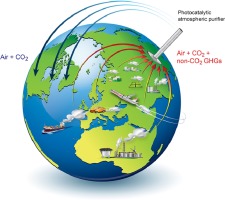当前位置:
X-MOL 学术
›
Prog. Energy Combust. Sci.
›
论文详情
Our official English website, www.x-mol.net, welcomes your feedback! (Note: you will need to create a separate account there.)
Removal of non-CO 2 greenhouse gases by large-scale atmospheric solar photocatalysis
Progress in Energy and Combustion Science ( IF 29.5 ) Pub Date : 2017-05-01 , DOI: 10.1016/j.pecs.2017.01.001 Renaud de_Richter , Tingzhen Ming , Philip Davies , Wei Liu , Sylvain Caillol
Progress in Energy and Combustion Science ( IF 29.5 ) Pub Date : 2017-05-01 , DOI: 10.1016/j.pecs.2017.01.001 Renaud de_Richter , Tingzhen Ming , Philip Davies , Wei Liu , Sylvain Caillol

|
Large-scale atmospheric removal of greenhouse gases (GHGs) including methane, nitrous oxide and ozone-depleting halocarbons could reduce global warming more quickly than atmospheric removal of CO2. Photocatalysis of methane oxidizes it to CO2, effectively reducing its global warming potential (GWP) by at least 90%. Nitrous oxide can be reduced to nitrogen and oxygen by photocatalysis; meanwhile halocarbons can be mineralized by red-ox photocatalytic reactions to acid halides and CO2. Photocatalysis avoids the need for capture and sequestration of these atmospheric components. Here review an unusual hybrid device combining photocatalysis with carbon-free electricity with no-intermittency based on the solar updraft chimney. Then we review experimental evidence regarding photocatalytic transformations of non-CO2 GHGs. We propose to combine TiO2-photocatalysis with solar chimney power plants (SCPPs) to cleanse the atmosphere of non-CO2 GHGs. Worldwide installation of 50,000 SCPPs, each of capacity 200 MW, would generate a cumulative 34 PWh of renewable electricity by 2050, taking into account construction time. These SCPPs equipped with photocatalyst would process 1 atmospheric volume each 14–16 years, reducing or stopping the atmospheric growth rate of the non-CO2 GHGs and progressively reducing their atmospheric concentrations. Removal of methane, as compared to other GHGs, has enhanced efficacy in reducing radiative forcing because it liberates more °OH radicals to accelerate the cleaning of the troposphere. The overall reduction in non-CO2 GHG concentration would help to limit global temperature rise. By physically linking greenhouse gas removal to renewable electricity generation, the hybrid concept would avoid the moral hazard associated with most other climate engineering proposals.
中文翻译:

通过大规模大气太阳能光催化去除非CO 2 温室气体
大规模大气去除温室气体 (GHG) 包括甲烷、一氧化二氮和消耗臭氧层的卤烃可以比大气去除二氧化碳更快地减少全球变暖。甲烷的光催化将其氧化为 CO2,有效地将其全球变暖潜能值 (GWP) 降低至少 90%。一氧化二氮可通过光催化还原为氮和氧;同时,卤代烃可以通过氧化还原光催化反应生成酰卤和 CO2 来矿化。光催化避免了对这些大气成分的捕获和封存的需要。这里回顾了一种不寻常的混合装置,它将光催化与无碳电力相结合,基于太阳能上升气流烟囱。然后我们回顾了关于非 CO2 温室气体光催化转化的实验证据。我们建议将 TiO2 光催化与太阳能烟囱发电厂 (SCPP) 相结合,以净化大气中的非二氧化碳温室气体。考虑到建设时间,全球安装 50,000 个 SCPP,每个容量为 200 兆瓦,到 2050 年将产生累计 34 PWh 的可再生电力。这些配备光催化剂的 SCPP 将每 14-16 年处理 1 个大气体积,降低或停止非 CO2 温室气体的大气增长率并逐步降低其大气浓度。与其他温室气体相比,去除甲烷在减少辐射强迫方面具有更强的功效,因为它会释放更多的°OH 自由基以加速对流层的清洁。非二氧化碳温室气体浓度的整体降低将有助于限制全球温度上升。
更新日期:2017-05-01
中文翻译:

通过大规模大气太阳能光催化去除非CO 2 温室气体
大规模大气去除温室气体 (GHG) 包括甲烷、一氧化二氮和消耗臭氧层的卤烃可以比大气去除二氧化碳更快地减少全球变暖。甲烷的光催化将其氧化为 CO2,有效地将其全球变暖潜能值 (GWP) 降低至少 90%。一氧化二氮可通过光催化还原为氮和氧;同时,卤代烃可以通过氧化还原光催化反应生成酰卤和 CO2 来矿化。光催化避免了对这些大气成分的捕获和封存的需要。这里回顾了一种不寻常的混合装置,它将光催化与无碳电力相结合,基于太阳能上升气流烟囱。然后我们回顾了关于非 CO2 温室气体光催化转化的实验证据。我们建议将 TiO2 光催化与太阳能烟囱发电厂 (SCPP) 相结合,以净化大气中的非二氧化碳温室气体。考虑到建设时间,全球安装 50,000 个 SCPP,每个容量为 200 兆瓦,到 2050 年将产生累计 34 PWh 的可再生电力。这些配备光催化剂的 SCPP 将每 14-16 年处理 1 个大气体积,降低或停止非 CO2 温室气体的大气增长率并逐步降低其大气浓度。与其他温室气体相比,去除甲烷在减少辐射强迫方面具有更强的功效,因为它会释放更多的°OH 自由基以加速对流层的清洁。非二氧化碳温室气体浓度的整体降低将有助于限制全球温度上升。


























 京公网安备 11010802027423号
京公网安备 11010802027423号